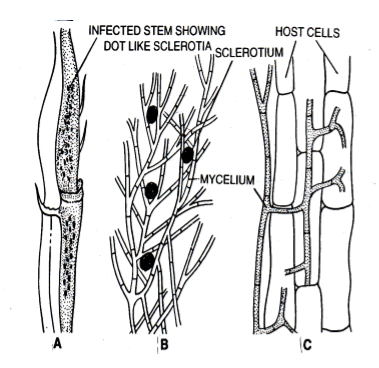Stem rot of rice management
Causal organism of Stem rot of rice
Sclerotium oryzae.
Distribution of Stem rot of rice
The disease has been reported from all rice growing countries such as Japan, Chaina, Philippines, Srilanka, Italy, Brazil, USA, etc. The sclerotial stage of stem rot of rice was first described by cattaneo from Italy in 1876. In India, the disease was first reported by shaw from Bengal in 1911.
Symptoms of Stem rot of rice
The disease is commonly found in the transplanted crop in the month of July-September. First of all small dark lesions are developed on the outer leaf sheath at the water line. Later on this lesions gradually make their appearance on the inner leaf sheaths and the culm. The affected and numerous small dark brown sclerotia are formed in the tissues of leaf sheath. In later stages, the mycelial mats and the sclerotia are copiously formed inside the culm also. Rotting remains restricted to a few lower internodes. As the plants matured the intensity of infection is increased. The culms collapse and plants lodge heavily, when the infection attackes place later in the growing season the grains are much shrivelled.
Nature & recurrent of Stem rot of rice
The sclerotia float on water and spread from fields to fields or plant to plant. The sclerotia are responsible for primary infection. Whereas, when the conidia are produced. They are also spread through the irrigation water and secondary infection may be caused.
Favourable condition of Stem rot of rice
i. Excessive flooding.
ii. Early & late varieties.
iii. Excess use of nutrients nitrogenous fertilizer.
iv. Excess use of phosphorus fertilizer.
Control measure/Management of Stem rot of rice
i. Resistant varieties: The best method of disease control is to use resistant varieties.
ii. Clean cultivation.
iii. Crop rotation.
iv. Proper manuring.

